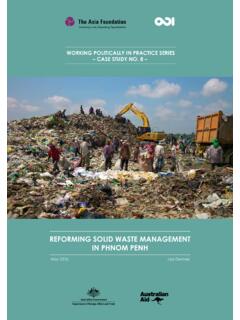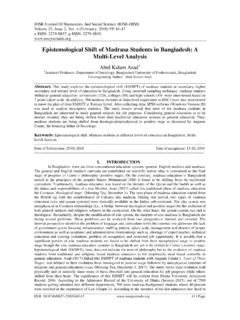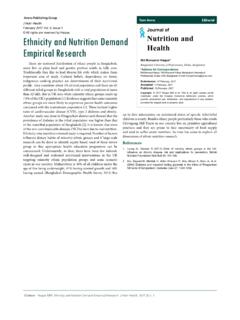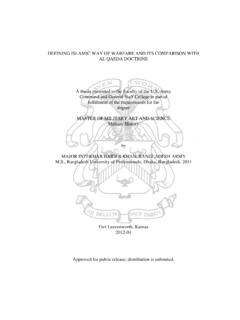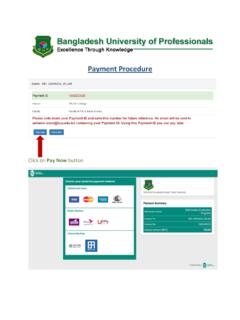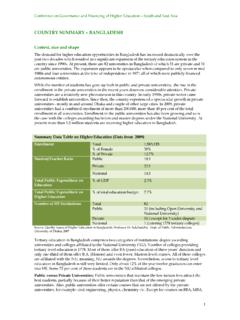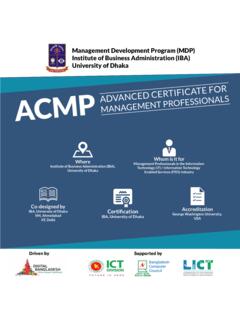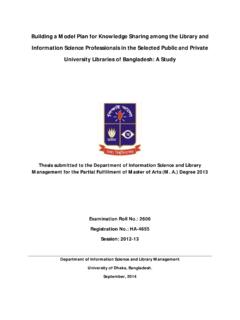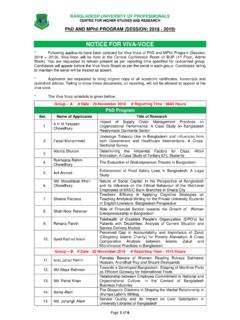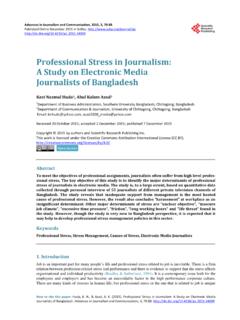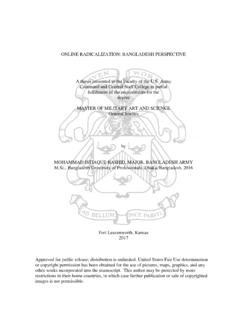Transcription of CLIMATE CHANGE PERCEPTION SURVEY - The Asia Foundation
1 CLIMATE CHANGEPERCEPTION SURVEYH ouse 5, Road 8, Baridhara, Dhaka, bangladesh Phone +880-2-882-6941, Fax + photo: Conor AshleighNYMPHEA I on CLIMATE CHANGE PERCEPTION SURVEY December 20122 Report on CLIMATE CHANGE PERCEPTION SURVEY December 20121 Report on CLIMATE CHANGE PERCEPTION SURVEY December 2012 CLIMATE CHANGEPERCEPTION SURVEYD haka, BangladeshDecember 2012 Table of of the of Geographic Method and Size Calculation for Household Size for Key Informant Interview (KII) Method and Participant Structure172 Context CLIMATE CHANGE and of bangladesh Response.
2 Discourse, Policies and of the Study of Living with Natural Disasters213 People s Knowledge of CLIMATE CLIMATE CHANGE : It s Meaning and of the CHANGE in Vulnerable CHANGE Impact at Household on Causes of CLIMATE CHANGE Responsibilities: Who Will Solve CLIMATE CHANGE Problems374 Adapting to CLIMATE CHANGE : people s needs and s Actions to Adapt to CLIMATE of of CHANGE of Livelihoods Due to CLIMATE CHANGE 375 CLIMATE CHANGE Policy and s Plan to Deal with CLIMATE CHANGE to Deal with CLIMATE Awareness of Programs s Experience about the Workings of CLIMATE CHANGE to the Most Vulnerable People of the Programs to Prioritize the Most Vulnerable People of Delivering Used for Implementing the programs s View about the Most Appropriate Channel for Program Delivery at Local Level 432 Report on CLIMATE CHANGE PERCEPTION SURVEY December and of Any Plan on
3 Disaster Management of Prticipation of the Respondent in and Girl s Participation in the to Increase People s of Obtaining Services Related to CLIMATE through which Services are Delivered to the Benefi Provided to the Benefi and Governance of CLIMATE CHANGE c Programs Based on CLIMATE CHANGE on Fund Allocated for CLIMATE of Fund y Introduced to Adapt to CLIMATE Change486 Conclusions and and PERCEPTION of CLIMATE CHANGE and Its Eff of Natural Practices to Adapt to CLIMATE in CLIMATE CHANGE Recommendations517 Annexes: Additional Tables553 Report on CLIMATE CHANGE PERCEPTION SURVEY December 2012 Table Sample distribution Table Type of respondents for the KII SURVEY for each upazilaTable Sampling distribution for FGDT able Extent of weather changes aff ect in the areaTable Technolog y used to adapt to CLIMATE CHANGE in the study areas (from KII)Annexes Tables.
4 Table Respondents highest level of education, by age and gender (%)Table profi le according to occupation and gender (%)Table distribution of respondents according to their reported impact of last natural disaster on their life and livelihoodTable distribution of respondents according to their observed weather CHANGE pattern over the last 10-30 years, by hazard zonesTable distribution of respondents according to the reported CLIMATE CHANGE eff ects at the household levelTable Respondents opinion on how CLIMATE CHANGE problems can be mitigated (% of households)Table Action of Government to deal CLIMATE CHANGE (% of households)
5 Table distribution of respondents according to the reported actions taken to adapt to CLIMATE changeTable for not doing anything to adapt to CLIMATE ChangeTable of respondents on Government s plans to deal with CLIMATE CHANGE , by information coverageTable distribution of respondents according to their knowledge of work of Government to deal with CLIMATE CHANGE (by hazard zone)Table distributions of respondents on what Government or Union Parishad is doing to deal with CLIMATE changeTable level of knowledge regarding diff erent aspects of programs being implemented in the study areasTable level of knowledge regarding diff erent aspects of programs being implemented in the study areas according to information coverage (%)Table level of knowledge regarding diff erent aspects of programs being implemented in the study areas according to gender (%)
6 Table distribution of respondents opinion on Channel used for implementing the programsTable opinion on what needs to be done to increase their participation in local level planning of CLIMATE CHANGE or disaster management plansTable opinions as to the channels from which they are receiving benefi ts from intervention programs related to CLIMATE changeTable distribution of respondents according to their opinion on resources provided to the respondents for coping/adapting with CLIMATE changeTable c programs in study areas based on the CLIMATE CHANGE plan (from KII)Table y used to adapt to CLIMATE CHANGE in the study areas (from KII)
7 List of Tables4 Report on CLIMATE CHANGE PERCEPTION SURVEY December 20125 Report on CLIMATE CHANGE PERCEPTION SURVEY December 2012 ADBTh e Asian Development BankBCASB angladesh Center for Advanced Studies BCCRFB angladesh CLIMATE CHANGE Resilience Fund BCCSAPB angladesh CLIMATE CHANGE Strateg y Action Plan BCCTFB angladesh CLIMATE CHANGE Trust Fund BIDSB angladesh Institute of Development Studies BUETB angladesh university of Engineering and Technolog y BUPB angladesh university of Professionals C&SCyclone and SalinityCBOC ommunity Based Organization CBOC ommunity-based OrganizationCCClimate CHANGE CDMC lean Development Mechanism CDMPC omprehensive Disaster Management Program CHTC hittagong Hill Tracts CIDAC anadian International Development Agency CPEIRC limate Public Expenditure and Institutional Review CSOC ivil Society Organization DRRD isaster Risk Reduction FGDF ocus Group Discussion GBM Ganges-Brahmaputra-Meghna GCCG lobal CLIMATE CHANGE GEFG lobal Environment Facility GHGG reenhouse Gas GoBGovernment of bangladesh IPCCI ntergovernmental Panel on CLIMATE ChangeKIIKey Informant InterviewMENDM oving
8 Towards Emission Neutral Development NAPA National Adaptation Program of Action NCNational Communication NGONon-government Organization PREGAP romotion of Renewable Energ y, Energ y Effi ciency and Greenhouse Gas Abatement PSUP rimary Sampling UnitSFYPS ixth Five Year Plan SMRCSAARC Meteorolog y Research Centre SPCRS trategic Program for CLIMATE Resilience SRDISoil Research Development InstituteSSNS outh-South-North TATechnical AssistanceUNDPU nited Nations Development Program UNFCCCU nited Nations Framework Convention on CLIMATE CHANGE UNOU pazila Nirbahi Offi cerAbbreviationsFigure : Level of education of respondentsFigure : Percentage of respondents involved in livelihoods directly sensitive to CLIMATE changeFigure.
9 Percentage of respondents reporting losses during last natural disaster they facedFigure : Percentage distribution of respondents by type of losses during last natural disaster encounteredFigure : What respondents mean by the term CLIMATE CHANGE Figure : Opinion on impact of CLIMATE CHANGE in the study areas (by hazard zone)Figure : Opinion on impact of CLIMATE CHANGE in the study areas (by gender)Figure : Percentage distribution of respondents according to the observed weather CHANGE pattern over the last 10-30 yearsFigure : Distribution of respondents according to their reported results of weather CHANGE pattern over the last 10-30 yearsFigure : Households aff ected by CLIMATE CHANGE in diff erent hazard zonesFigure : Eff ects at the household level suff ered by households aff ected by CLIMATE changeFigure : Percentage distribution of respondents according to their perceived likelihood of their households being aff ected by CLIMATE changeFigure : Opinion of respondents on main causes of weather changeFigure.
10 Opinion of key informants on main causes of CLIMATE changeFigure : Percentage of respondents who said Yes to the question whether there is anybody responsible for CLIMATE changeFigure : People s perceptions (by gender) about who is responsible for CLIMATE changeFigure : People s perceptions (by hazard zone) about who is responsible for CLIMATE changeFigure : Opinion of respondents (by gender) whether CLIMATE CHANGE problems can be mitigatedFigure : Opinion of respondents (by education level) whether CLIMATE CHANGE problems can be mitigatedFigure : Respondents opinions on how CLIMATE CHANGE problems can be mitigatedFigure : Percentage of respondents who reported taking some measures to adapt to CLIMATE changeFigure : Percentage distribution of respondents (who took adaptation measures) according to the reported actions they tookFigure : Reasons for not doing anything to adapt to CLIMATE changeFigure : What people needed to mitigate the problems they faced during the last natural disasterFigure : Likelihood of permanent migration, by hazard zonesFigure : Likelihood of permanent migration, by g
